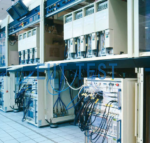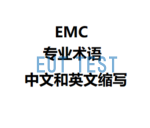Overview:
EMC electromagnetic compatibility testing is the testing of equipment according to the methods specified in the relevant electromagnetic compatibility standards to assess whether it meets the standard requirements. The EMC performance of the product must meet the standard requirements before finalizing the product and entering the market. The following is to understand the common EMC test project name and test purpose.
Learn more 🡪About the concept of EMC electromagnetic compatibility
EMC measurement is mainly divided into two categories: electromagnetic interference EMI test and electromagnetic immunity EMS test, so the test instruments and systems are also divided into two categories of EMI test equipment and EMS test equipment.
The term EUT is used hereafter as an abbreviation for "object under test".
EMC test program -EMI Test Systems::
EMI Electromagnetic Emission Test Program
Radiation emission RE
The purpose of a radiated emission test instrument is to measure the electromagnetic energy propagated through space by the EUT.
Conducted Emission CE
The purpose of a conducted emission test instrument is to measure the electromagnetic energy propagating along the EUT power, control or signal lines.
EMC test program -EMS Immunity Test System
Radiosensitivity test RS
Radiation sensitivity instruments are tested to measure the immunity of the EUT to space electromagnetic disturbances.
Radiation sensitivity test for industrial frequency magnetic fields PMS
The purpose of the test of the industrial frequency magnetic field instrument is to check the immunity of the EUT to industrial frequency magnetic fields at frequencies such as 50Hz/60Hz.
Conductivity sensitivity of RF field sensing CS
The purpose of the instrumentation for testing the conductive sensitivity of RF field induction is to measure the sensitivity of the EUT to electromagnetic energy transmitted along power, control, or signal lines.
Electrical fast transient pulse group immunity EFT /B
The test purpose of the electric fast transient pulse group instrument is to simulate the EUT switching of inductive loads (e.g., relays, contactors); switching of high-voltage switches (e.g., vacuum switches, sulfur hexafluoride) equipment interference. The discharge waveform is a 5ns/50ns (rising edge 5ns, half-wave time 50ns) pulse train with a duration of 15ms and a pulse period of 300ms. it is characterized by a fast rise time, short duration and low energy, but with a high repetition frequency.
Surge immunity SURGE
The purpose of the surge instrument is to simulate faults in the grid; lightning strikes (direct or indirect) on the EUT, and switching operations in the grid. The discharge waveforms are pulses of 1.2us/50us for open circuit voltage and 8us/20us for short circuit current. It is characterized by a slow rise time (relative to EFT/B), long duration and high energy.
Voltage drop and interruption immunity DIPs
The purpose of the Voltage Dips and Interruptions test apparatus is to simulate instantaneous voltage dips and interruptions caused by faults (short circuits or earth faults) in the LV, MV or HV network; as well as voltage variations caused by continuous changes in the loads connected to the grid.
Power line sense/contact
The purpose of the power line sensing instrument is to simulate an outdoor EUT with a signal line that is too close to the power line or a contact fault.
Electrostatic discharge immunity ESD
The purpose of an ESD instrument is to simulate the discharge of an operator or object in contact with an EUT and the discharge of a person or object to neighboring objects.
Evaluation of EMC test results
For EMI test results, the criterion is whether or not a certain limit is met; for EMS tests, the performance criteria can be categorized into four levels:
Level A: Normal performance indicators in the test;
Level B: Temporary reduction in performance during the test, no loss of function, and self-recovery after the test;
Grade C: Allowable loss of function, but self-recovering, or recoverable with operator intervention;
Class R: No irrecoverable loss of function or degradation of performance due to damage to equipment (components) or software or loss of data is permitted, except for protection elements.





